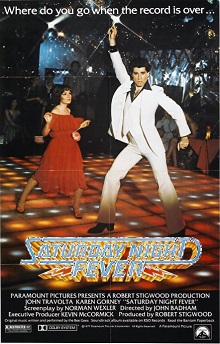Everything about this film, its title, the poster with John Travolta’s iconic pose and of course the Bee Gees songs, have long been subsumed into popular culture. But I’ve never watched it before now and I wonder how many people really have. It would be so easy to dismiss this as a standard dance movie about the protagonists trying to win a dance competition but it is so much more than that. In parallel with the disco dancing which is of course wonderful to watch, this is a fairly serious drama about a young man learning to grow out the milieu he has grown up in and I loved how both tracks complement each other so perfectly.
Tony Manero is a perfectly ordinary young man from a working-class Italian-American background and is content with a job in a small hardware store. But on weekend nights, he reigns as the undisputed king of his local disco with his impressive dance moves, immaculate grooming and flashy fashion style. A succession of girls readily come on to him, including the very desperate Annette, and he is the leader of his group of friends. When the disco holds a dance competition with a large cash reward, Tony naturally joins but is unsatisfied with Annette as his partner. Then he notices a newcomer at the disco, Stephanie, who is older than he is but dances very well and aggressively tries to get to know her. He learns that she was originally from Brooklyn but has since moved across the river in search of a more prosperous and sophisticated lifestyle. Though he manages to convince her to be his partner for the competition, he fails to connect with her more generally as she looks down on him as being immature with no thought for his future.
Director John Badham isn’t particularly known for making great films but a few are both commercial and critical hits that have held up well including WarGames and Short Circuit. Saturday Night Fever was one of his earliest films however and it strikes me how much more serious and better it is than anything else in his filmography. The energy in this film is evident beginning with Travolta’s confident strut as he walks on the street, even if he is just carrying a pail of paint. The dancing is naturally spectacular and who can resist the music of the Bee Gees but the directorial choices even there are so much more nuanced than that. Normally we would expect Manero’s best performance as the climax of the film at the competition but in fact the last dance is surprisingly subdued. Rather than trying to wow the audience as a visual spectacle, it is meant to emphasize a newfound emotional connection between Tony and Stephanie. Similarly there is a lot of complexity in the stories of the other characters around Tony, including his brother who only became a priest to please their parents, his friend Bobby who got a girl pregnant and feels forced into a marriage he doesn’t want and so on.
Every thread in this film points in the same direction: how one must grow beyond the family and the childhood home to lead a better life. Some modern viewers remark about the racism and the callous attitude towards women evinced by Tony’s friends, but the film actually uses these as more ways that Tony has to learn to be better and to grow out of in-grained bad habits. On the other hand, the film seems to treat moving out of Brooklyn as being an unalloyed good but Stephanie seems like she is trying too hard to convince everyone including herself that her new lifestyle is actually better. Tony doesn’t seem equipped to fully realize tat Stephanie had made compromises of her own to have this new life but the film and audiences should know better. Still I do appreciate the ending with the acknowledgment that Stephanie is more emotionally mature than Tony so their relationship isn’t that of being lovers.
The original screenplay was born out of a magazine article about the disco subculture that has since been proven to be largely fictitious. So it’s quite ironic that this has lead to what is probably the most influential disco dance film of all time. Tony Manero is easily one of the most iconic characters in cinema and at the same time the film is more than just a superficial dance movie. It also occupies a sweet spot in being entertaining enough for just about everyone and being an excellent drama due to its themes and characterization.
